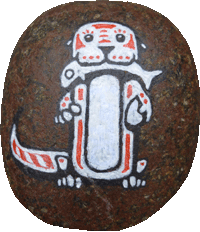12th December 2010
Again with the early start. Again watching the light grow over the mangrove. Again the otter appears out of nowhere. This time Jan and I follow the old adage “a bird in the hand is worth two in the bush” and we snap photos. Naturally, the camera-click alerts this incredibly alert and secretive animal, and it vanishes again. For five minutes we hear the otter splashing and sneezing alongside the hide (but no window looks out that way!) but it decides discretion is the better part of valour, and we hear it no more.
That’s our lot for hairy-nosed otters: two brief views and a photo. So rather than a very short blog, let me tell you what we know about this special otter…
Everything you want to know about the hairy-nosed otter
The hairy-nosed otter is one of the least understood and rarest otters in the world. However, it is a little less rare than initially thought, as in the last few years populations have been discovered in Cambodia, Thailand, Vietnam and Malaysia. This is probably due to its very secretive nature and preferred habitat of mangrove swamps; these are very difficult places for people to go and look for or observe animals, as we can testify!What is known from the research at Hala Bala is that the hairy-nosed otter probably uses sight more than other otters when hunting; the waters of the mangrove are crystal clear, and camera traps have captured otters during the day but none at night. Their diet is mostly fish, but also snakes, terrapins and frogs in descending proportions. The population in southern Thailand has learned how to break into fish traps to steal the fish, although this doesn’t seem to have created a problem with the local Thai community.
The hairy-nosed otter is a big otter, probably a little larger than the British otter, and its most distinctive feature is that fur covers its nose (whereas other otters have a dark shiny nose like a dog). Hairy-nosed otters are mostly solitary, but small family groups have been seen. Cubs seem to be born at the end of the wet season. There are no known natural predators, and causes of mortality in southern Thailand have included road deaths and drowning in fish traps.
Related Images:













































